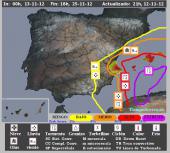Letra E
|
- E - Pendant Echo - Radar signature generally similar to a hook echo, except that the hook shape is not as well defined. Eco Colgante - Señal de radar generalmente similar a un eco en gancho, excepto que la forma de gancho no está tan bien definida. Bow Echo - A radar echo which is linear but bent outward in a bow shape (Fig. 1). Damaging straight-line winds often occur near the "crest" or justify of a bow echo. Areas of circulation also can develop at either end of a bow echo, which sometimes can lead to tornado formation - especially in the left (usually northern) end, where the circulation exhibits cyclonic rotation. Comma Echo - A thunderstorm radar echo which has a comma-like shape. It often appears during latter stages in the life cycle of a bow echo. Orographic Lift - Lifting of air caused by its passage up and over mountains or other sloping terrain. Elevador Orográfico - Ascenso de aire causado por su paso hacia arriba sobre las montañas u otro terreno empinado. Cold-air Funnel - A funnel cloud or (rarely) a small, relatively weak tornado that can develop from a small shower or thunderstorm when the air aloft is unusually cold (hence the name). They are much less violent than other types of tornadoes. Condensation Funnel - A funnel-shaped cloud associated with rotation and consisting of condensed water droplets (as opposed to smoke, dust, debris, etc.). Compare with debris cloud. Box (or Watch Box) - [Slang], a severe thunderstorm or tornado watch. See blue box, red box. Mid-level Cooling - Local cooling of the air in middle levels of the atmosphere (roughly 8 to 25 thousand feet), which can lead to destabilization of the entire atmosphere if all other factors are equal. Mid-level cooling can occur, for example, with the approach of a mid-level cold pool. Enfriamiento de Niveles Medios - Enfriamiento local del aire en niveles medios de la atmósfera (de 8.000 a 25.000 pies aprox.), que puede llevar a la desestabilización de la totalidad de la atmósfera si todos los otros factores son iguales. El enfriamiento en niveles medios puede ocurrir, por ejemplo, con la aproximación de una bolsa fría. Inflow Stinger - A beaver tail cloud with a stinger-like shape. Entrada en Aguijón – Nube “cola de castor” con forma de aguijón. CAPE - Convective Available Potential Energy. A measure of the amount of energy available for convection. CAPE is directly related to the maximum potential vertical speed within an updraft; thus, higher values indicate greater potential for severe weather. Observed values in thunderstorm environments often may exceed 1,000 joules per kilogram (j/kg), and in extreme cases may exceed 5,000 j/kg. However, as with other indices or indicators, there are no threshold values above which severe weather becomes imminent. CAPE is represented on a sounding by the area enclosed between the environmental temperature profile and the path of a rising air parcel, over the layer within which the latter is warmer than the former. (This area often is called positive area.) See also CIN and sounding. Fujita Scale (or F Scale) - A scale of wind damage intensity in which wind speeds are inferred from an analysis of wind damage: F scale - See Fujita Scale. Morning Glory - An elongated cloud band, visually similar to a roll cloud, usually appearing in the morning hours, when the atmosphere is relatively stable. Morning glories result from perturbations related to gravitational waves in a stable boundary layer. They are similar to ripples on a water surface; several parallel morning glories often can be seen propagating in the same direction. Esplendor de la Mañana - Banda nubosa elongada, visualmente similar a una nube en rodillo (roll-cloud), que normalmente aparece en las horas de la mañana, cuando la atmósfera es relativamente estable. Los Esplendores de la Mañana resultan de perturbaciones relacionadas con ondas gravotatorias en un estrato fronterizo estable. Son similares a las ondas sobre una superficie de agua; algunos Esplendores de la Mañana paralelos se pueden ver a menudo propagándose en la misma dirección. Boundary Layer - In general, a layer of air adjacent to a bounding surface. Specifically, the term most often refers to the planetary boundary layer, which is the layer within which the effects of friction are significant. For the earth, this layer is considered to be roughly the lowest one or two kilometers of the atmosphere. It is within this layer that temperatures are most strongly affected by daytime insolation and nighttime radiational cooling, and winds are affected by friction with the earth's surface. The effects of friction die out gradually with height, so the "top" of this layer cannot be defined exactly. Estrato Fronterizo - En general, estrato de aire adyacente a una superficie fronteriza. Específicamente, el término se refiere más a menudo al “estrato fronterizo planetario” que es el estrato dentro del cual los efectos de fricción son significativos. En el caso de la Tierra, este estrato se refiere al estrato aproximadamente más bajo en el primer y segundo kilómetro de la atmósfera. Es dentro de éste en el que las temperaturas están más fuertemente afectadas por la insolación diaria y el enfriamiento por irradiación nocturna, y los vientos están afectados por la fricción con la superficie terrestre. Los efectos de la fricción desaparecen gradualmente con la altura de modo que el “techo” del estrato no se puede definir con exactitud.
|
© Spain Severe Weather 2010








